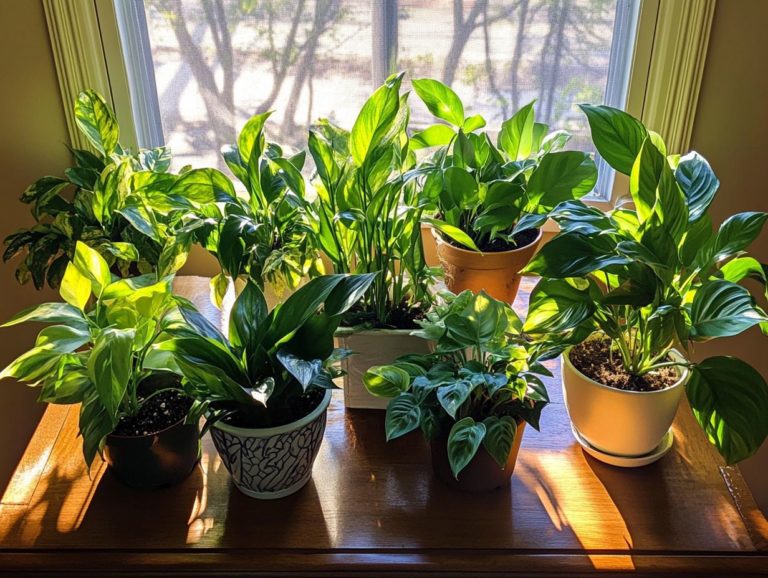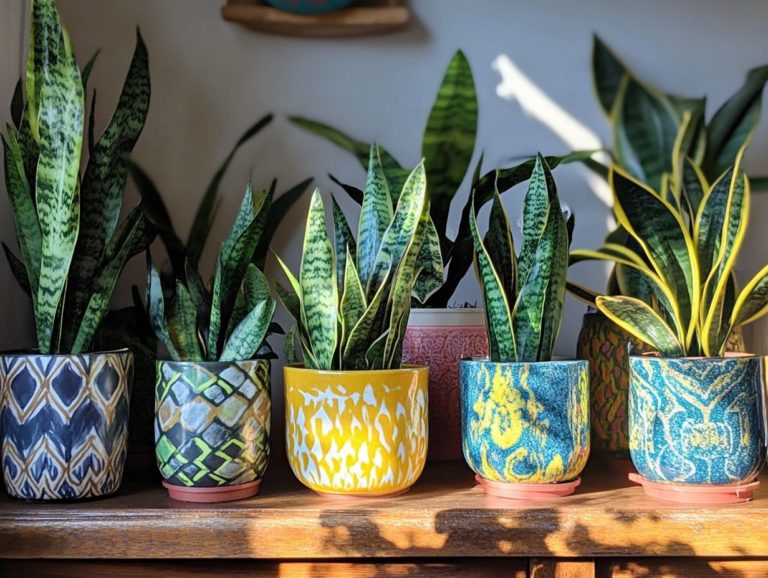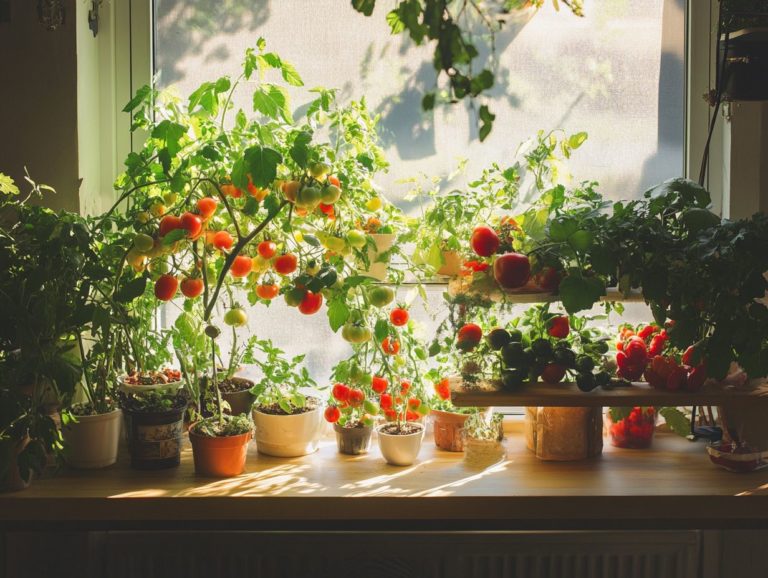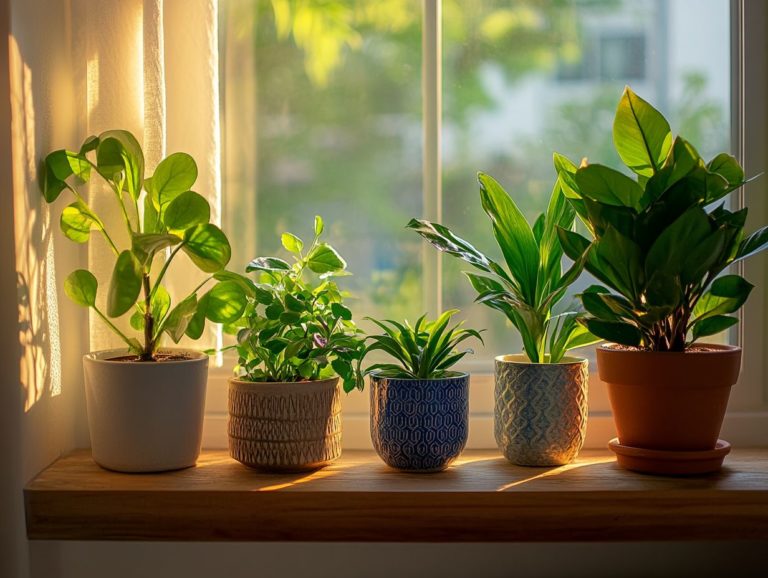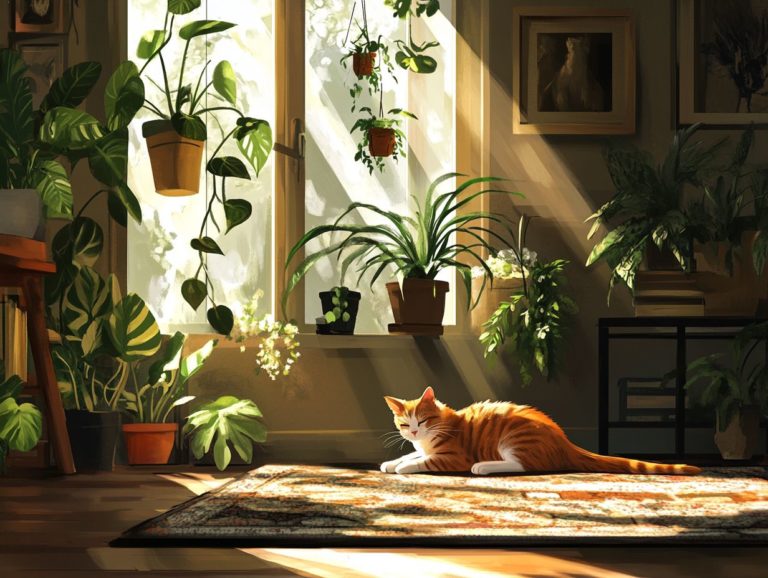Top 5 Indoor Plants for Seasonal Changes
Indoor plants do more than just add a splash of green to your space; they bring a wealth of benefits, especially as the seasons shift. Imagine breathing in purer air and enjoying enhanced home decor. Selecting the right greenery can cultivate a soothing atmosphere throughout the year.
You ll explore the top five indoor plants that thrive in different seasons, along with essential care tips and strategies to sidestep common pitfalls. Whether you re an experienced plant parent or just starting out in indoor gardening, you ll discover how to keep your indoor oasis lush and vibrant all year long.
Contents
- Key Takeaways:
- 1. Snake Plant
- 2. Peace Lily
- 3. Spider Plant
- 4. Aloe Vera
- 5. English Ivy
- How Do Indoor Plants Help with Seasonal Changes?
- What Are the Best Indoor Plants for Winter?
- What Are the Best Indoor Plants for Summer?
- What Are the Best Indoor Plants for Spring?
- What Are the Best Indoor Plants for Fall?
- How Can Indoor Plants Improve Air Quality and Reduce Allergies?
- What Are Some Tips for Taking Care of Indoor Plants during Seasonal Changes?
- What Are Some Common Mistakes to Avoid When Growing Indoor Plants?
- How Can Indoor Plants Enhance Home Decor during Seasonal Changes?
- What Are Some Creative Ways to Display Indoor Plants during Seasonal Changes?
- What Are Some Low-Maintenance Indoor Plants for Busy Individuals?
- Frequently Asked Questions
- What are the top 5 indoor plants for seasonal changes?
- Why are these plants recommended for seasonal changes?
- How do these plants help with seasonal changes?
- Do these plants require special care during certain seasons?
- Can these plants be grown in any climate?
- Are there any benefits to having these plants during seasonal changes?
Key Takeaways:
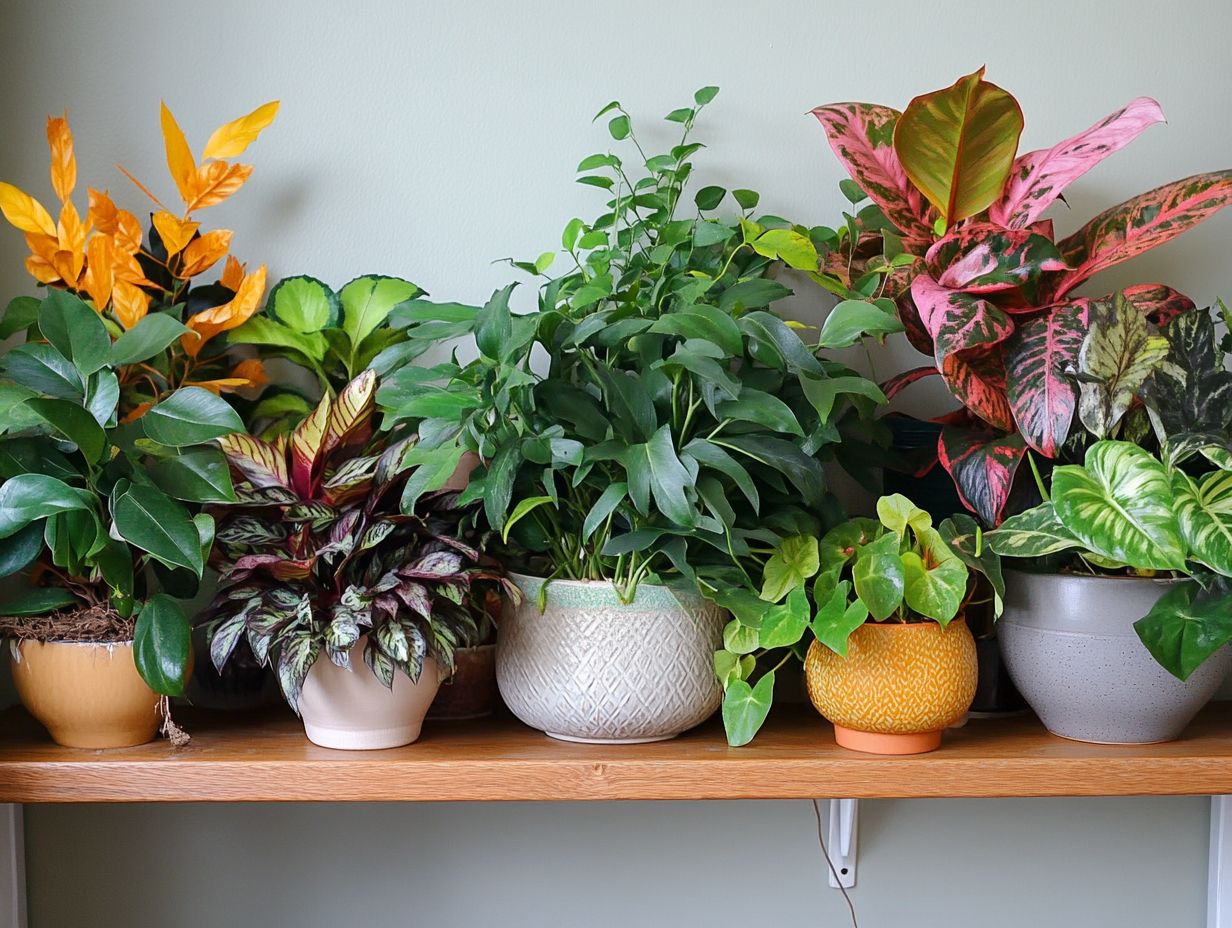
- Snake plants, peace lilies, spider plants, aloe vera, and English ivy are the top five indoor plants for seasonal changes.
- Indoor plants improve air quality, reduce allergies, and add nature to your decor.
- Care tips include adjusting watering and lighting, and avoiding over-fertilizing and poor drainage.
1. Snake Plant
The Snake Plant, often called Sansevieria or Mother-in-Law’s Tongue, is a robust indoor companion that thrives in low light and needs minimal care. This makes it a superb choice for winter houseplants, especially for those seeking resilient plants.
Its remarkable ability to withstand neglect and low humidity means even beginners can enjoy its striking presence without the stress of constant maintenance. It prefers soil that allows water to flow through easily and infrequent watering, making it perfect for busy lifestyles.
Its air-purifying properties enhance your indoor environment by filtering toxins and promoting cleaner air. This ultimately boosts your well-being. With its upright growth pattern, the Snake Plant harmonizes effortlessly with other indoor greenery, creating a stunning display that elevates the aesthetic of any room.
2. Peace Lily
The Peace Lily is celebrated for its elegant white blooms and exceptional air-purifying abilities. It stands out as a premier choice for your indoor spaces. This plant flourishes in warm conditions, making it particularly advantageous during the winter months when you need a touch of nature indoors.
Caring for this striking plant is simple. It thrives in indirect sunlight and prefers a humid environment. For optimal growth, position the Peace Lily near a north- or east-facing window, allowing it to bask in filtered light without the risk of scorching.
To maintain the right humidity levels, mist the plant occasionally or use a pebble tray both are effective methods to help it thrive. Beyond its visual appeal, placing the Peace Lily in common areas enhances the atmosphere, creating a calming ambiance that promotes relaxation and mindfulness in your home decor.
3. Spider Plant
The Spider Plant is a resilient indoor beauty, known for its long, arching leaves and charming, spider-like offshoots. It makes a striking addition to your home during the winter months. The best part? It’s incredibly easy to care for.
This amazing plant thrives even in dim light, making it a must-have for rooms that don t get much sunlight. Beyond its visual appeal, the Spider Plant is an expert at air purification, diligently filtering indoor pollutants and improving your overall air quality.
For optimal growth, water it moderately, allowing the soil to dry slightly between waterings. Propagation is simple; you can pot the delightful offshoots, affectionately known as ‘pups’, in fresh soil. By adding this versatile plant to your indoor greenery, you not only elevate the aesthetics of your space but also contribute to a healthier home environment.
4. Aloe Vera
Aloe Vera is a popular succulent known for its healing qualities and beautiful appearance. It s perfect for anyone looking for low-maintenance indoor plants that thrive in indirect sunlight, especially in winter.
This hardy plant enhances your decor and offers health benefits too. It soothes skin irritations and provides essential hydration, making it ideal for those who may forget to water occasionally.
To care for Aloe Vera, place it in a spot with bright, indirect sunlight for a few hours daily. Water it sparingly, allowing the soil to dry out completely between watering sessions. Avoid overwatering and placing it in dark corners, as these can lead to root rot.
5. English Ivy
English Ivy is a versatile climbing plant that serves as a great air-purifier. It thrives in cool temperatures and low light, making it a fantastic choice for winter gardening.
To keep your English Ivy healthy, pay attention to its care needs, such as regular watering and good soil management. Keeping humidity levels optimal helps too; mist the leaves or use a humidifier for the best results.
This plant isn t just pretty; it also reduces stress, creating a calming atmosphere. Consider using decorative trellises or hanging baskets to display its elegant vines beautifully.
How Do Indoor Plants Help with Seasonal Changes?
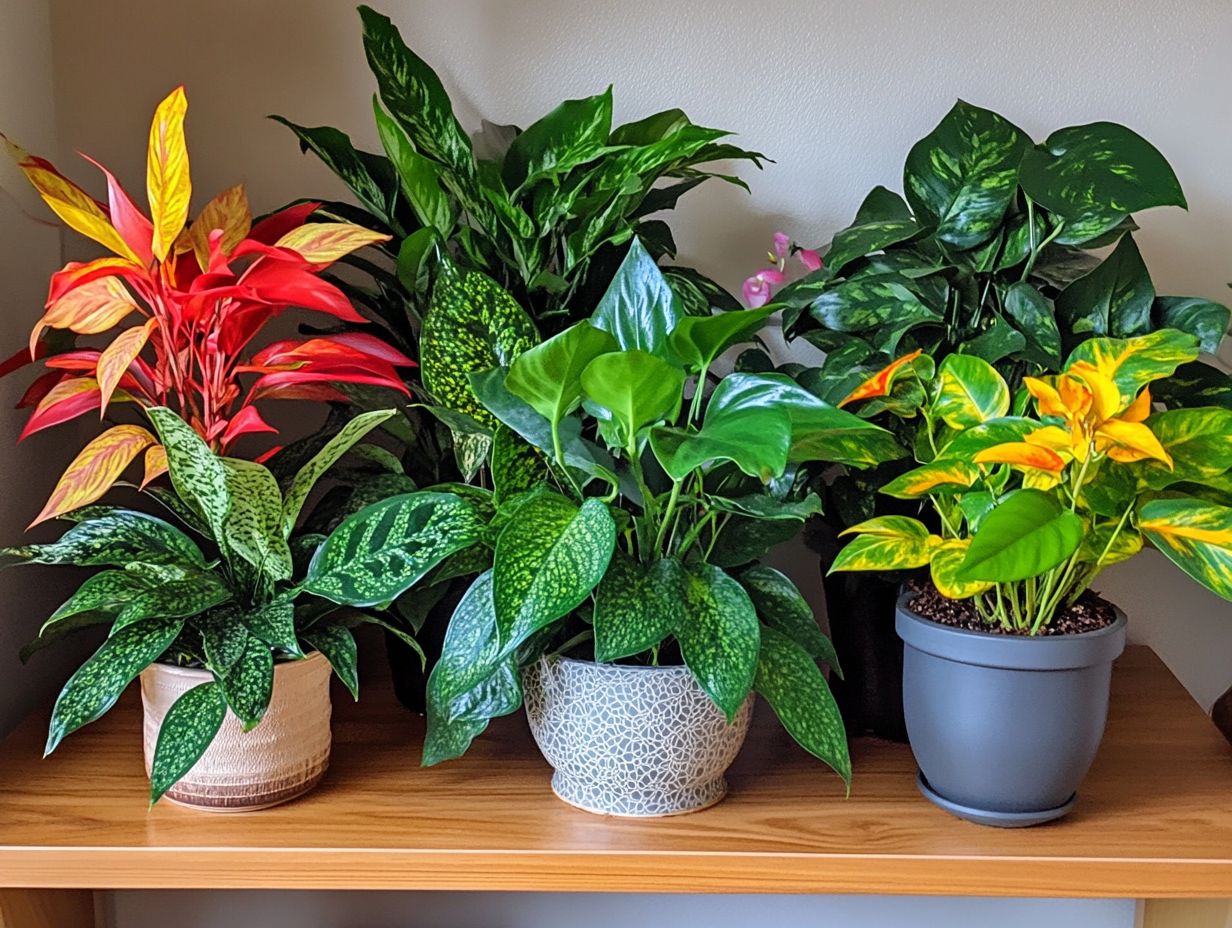
Indoor plants help us adapt to seasonal changes, especially in winter. They improve air quality, reduce stress, and connect us with nature, boosting our mood.
These green companions not only beautify your space but also purify the air, removing toxins. In dry winter air, plants like the peace lily and spider plant can help increase humidity, making your environment feel fresher.
Taking care of these plants can also give you a sense of purpose. This can alleviate anxiety and enhance your mental health.
By adding a variety of indoor plants, you can amplify these benefits. Create a sanctuary that nurtures both your psychological and physical well-being as the seasons change.
What Are the Best Indoor Plants for Winter?
Choosing the right indoor plants for winter means selecting resilient varieties that thrive in low light and chilly conditions. These plants offer both charm and practical benefits as temperatures drop.
For example, the Snake Plant purifies your air and adapts beautifully to different indoor settings. The Peace Lily is another excellent choice, thriving in low light while showcasing elegant white blooms to brighten your space.
Ensure these plants are kept away from cold drafts and receive indirect sunlight. To maintain humidity especially in heated homes consider using a small humidifier or grouping your plants together. This nurturing environment helps them thrive in winter.
What Are the Best Indoor Plants for Summer?
When you re selecting the best indoor plants for summer, it s vital to pick varieties that thrive in warm conditions. They can also infuse your living spaces with vibrant colors during those sunny months.
For example, the eye-catching Swiss cheese plant has distinct leaves, and the cheerful pothos makes any room look great. Both of these options flourish in elevated temperatures. They typically prefer bright, indirect light, which encourages their lush, colorful foliage. You’ll want to water them regularly, but let the top inch of soil dry out between waterings to avoid root rot, which can be detrimental to your plants. Incorporating these plants can also enhance your space, as detailed in our guide on using indoor plants for seasonal decor.
Watch out for pests like spider mites and aphids to keep your plants healthy. A gentle rinse with water or a bit of neem oil, a natural pest control solution, can effectively tackle any unwanted infestations. This ensures your plants stay happy and thriving.
What Are the Best Indoor Plants for Spring?
Selecting the best indoor plants for spring involves understanding the shifts in humidity levels and light exposure that characterize the season. This allows your indoor garden to truly flourish.
This season brings not only warmer temperatures but also increased daylight hours, significantly affecting how various plants thrive. Medium to low-light plants may need to be moved closer to windows to soak up that lovely natural light. For those looking to enhance their space, consider the top 5 indoor plants for seasonal decor, which thrive in bright conditions and should be monitored closely to avoid sunburn from those intense rays.
With humidity levels fluctuating, regularly check and adjust your watering schedule to keep your plants happy! By recognizing these changing conditions, you can strategically choose and care for plants like peace lilies and pothos to ensure their optimal growth and stunning beauty throughout the vibrant spring months.
What Are the Best Indoor Plants for Fall?
In the fall, selecting the right indoor plants can elevate your space. You can introduce seasonal selections that thrive in lower light while infusing a refreshing burst of greenery and warmth as the temperatures drop.
Experts suggest a few robust varieties that excel during this season, like the snake plant, famous for its resilience in dim conditions. The pothos is also admired for its cascading vines and impressive air-purifying abilities. For those living in tight spaces, exploring the top 5 indoor plants for small apartments can offer great options.
To help your plants thrive, make sure to place them away from drafts and intense heat sources. Sticking to a consistent watering routine is essential since overwatering can spell trouble. Opting for pots with excellent drainage will be beneficial, allowing ample room for growth.
Proper light exposure albeit indirect is essential. Finding a bright corner can significantly enhance their overall health and vibrancy.
How Can Indoor Plants Improve Air Quality and Reduce Allergies?
Indoor plants offer more than just a touch of beauty; they significantly enhance air quality and help diminish allergies, making them an invaluable asset to your living space.
Among the myriad options, the Peace Lily and English Ivy particularly excel as air-purifying champions. Studies reveal that the Peace Lily effectively absorbs harmful toxins like formaldehyde and benzene, while boosting humidity levels a boon for your respiratory health.
English Ivy is celebrated for its remarkable ability to filter airborne particles, drastically reducing mold levels. This makes it an excellent choice for homes with pets or bustling foot traffic.
These plants not only flourish indoors but also elevate the aesthetic charm of your environment, making your home healthier and more comfortable.
What Are Some Tips for Taking Care of Indoor Plants during Seasonal Changes?
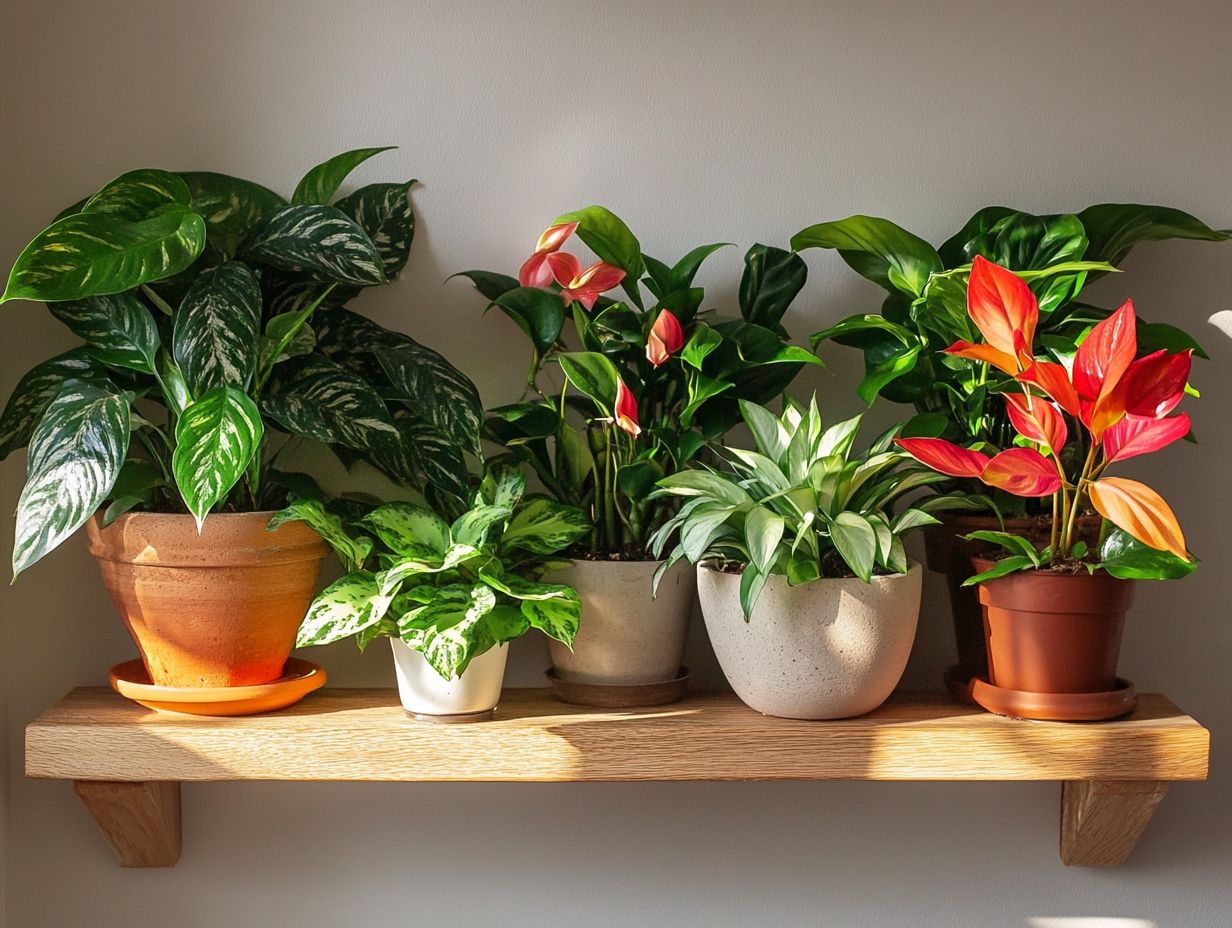
Taking care of indoor plants during seasonal changes requires attention. Focus on humidity, light, and watering needs. This will ensure their health and vibrancy throughout the year.
As the environment transitions from cold, dry air of winter to warm, humid conditions of summer, it’s crucial to adjust your care routines. During winter, your indoor plants typically require less water because they enter a time when they rest and grow less. To enhance your indoor gardening experience, consider incorporating the top 5 indoor plants that bloom as increasing humidity can alleviate the dry air caused by heating systems.
In summer, regular watering and placing plants near windows to capture sunlight can enhance their growth. A common pitfall in winter is overwatering. To avoid this, make it a habit to check the soil moisture regularly and adjust your watering schedule.
Keep a watchful eye on sudden temperature fluctuations near drafty windows or air conditioners, as these can stress your plants.
What Are Some Common Mistakes to Avoid When Growing Indoor Plants?
When nurturing indoor plants, you might stumble into common pitfalls that can stifle growth. These include overwatering, improper lighting, and overlooking seasonal adjustments.
These missteps can lead to root rot, stunted growth, and even the unfortunate loss of your cherished plants. To tackle overwatering, familiarize yourself with the specific water needs of each plant. Always check the moisture levels in the soil before reaching for the watering can.
For optimal lighting, consider using grow lights and positioning your plants in south-facing windows. This will ensure they bask in sufficient light year-round. To enhance your indoor space, check out the top 5 tropical plants for indoor environments. Evaluate how seasonal changes influence your indoor environment, like the drop in humidity during winter. Make necessary adjustments, such as adding a humidifier or relocating plants to sunnier spots during those darker months.
How Can Indoor Plants Enhance Home Decor during Seasonal Changes?
Indoor plants can truly elevate your home decor during seasonal transitions! They infuse vibrant colors, rich textures, and natural elements that create a refreshing atmosphere in any space.
By thoughtfully selecting a variety of plant species, you can transform your living areas into seasonal masterpieces. In spring, welcome lush, flowering plants like the African violet, adding a delightful burst of color. As summer arrives, embrace vibrant succulents such as the Echeveria, known for thriving in bright light and radiating warmth. For those with northern windows, consider the top 5 plants that flourish in lower light conditions.
When autumn rolls around, transition to plants with rich, warm hues like the red Aglaonema or the striking Croton. These can cultivate a cozy ambiance that invites comfort. As winter sets in, low-maintenance indoor plants like the ZZ plant not only bring texture but also thrive with minimal light. For more options, consider the top 5 shade-tolerant indoor plants, perfect for those darker days.
Arranging these plants in artistic groupings or showcasing them in decorative containers will enhance their aesthetic appeal. This will ensure your decor reflects the season and bursts with life and energy!
What Are Some Creative Ways to Display Indoor Plants during Seasonal Changes?
Displaying indoor plants creatively during seasonal changes can truly elevate your living space! It lets you showcase their beauty and enhance the overall ambiance.
One effective technique is to hang plants at varying heights near your windows. Let them cascade gracefully while soaking up the sun’s rays. Installing shelves offers an excellent platform for displaying a diverse array of plants, each thriving in its designated spot.
If you’re seeking something unique, consider creating terrariums. They bring a vibrant, miniature ecosystem right into your home! When positioning these green companions, think about their light requirements. Group them by needs, placing taller plants in the back and shorter ones in front for an eye-catching arrangement that draws the eye and brings your space to life.
What Are Some Low-Maintenance Indoor Plants for Busy Individuals?
Busy schedules call for low-maintenance indoor plants. These plants offer beautiful greenery without requiring extensive care.
Resilient options like the Snake Plant and ZZ Plant thrive even in tricky conditions. Enjoy vibrant foliage without spending much time on care.
The Snake Plant has striking upright leaves and cleans the air. It needs minimal watering, making it perfect for those with hectic lifestyles.
The ZZ Plant features glossy leaves and grows well in low light. A sprinkle of water every few weeks and occasional dusting keep it looking great.
Frequently Asked Questions
What are the top 5 indoor plants for seasonal changes?
The top 5 indoor plants for seasonal changes include the spider plant, peace lily, pothos, jade plant, and rubber tree.
Why are these plants recommended for seasonal changes?
These plants adapt to different temperature and humidity levels, making them suitable for various seasons.
How do these plants help with seasonal changes?
These plants help by purifying the air and increasing oxygen levels, which is especially beneficial during colder months when windows and doors are more likely to be closed.
Do these plants require special care during certain seasons?
While these plants do not require special care during certain seasons, it is important to monitor their watering and lighting needs as these may change depending on the season.
Can these plants be grown in any climate?
These plants can be grown in most climates as long as they are kept indoors. However, it is important to research specific care instructions for each plant to ensure they thrive in your particular climate.
Are there any benefits to having these plants during seasonal changes?
Yes, having these air-purifying plants during seasonal changes improves air quality, boosts mood and productivity, and adds greenery and life to your indoor space during cold conditions in the winter months.


